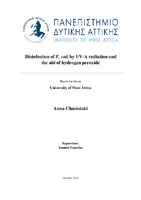| dc.description.abstract | The growth of the population brings with it a series of factors that increase at the same time, one of the main ones being the consumption and use of water; developing countries are the most affected in terms of access to drinking water and safe sanitation, and it is reflected in the report generated in June 2019 by the World Health Organization (WHO) in conjunction with the United Nations Fund United Nations for Children (UNICEF) where it indicates that 2,200 million people in the world do not have drinking water services and 4,200 million people do not have safe sanitation. As a result of this problem, organizations such as The Water Project, Charity: water, Water.org, International Water Association, among others, have emerged, which seek to create awareness about this resource, help access and seek solutions; and it is from the consumption and use of water that another problem is generated, such as the generation of wastewater. The treatment of drinking water in developing countries, especially people with limited resources and rural areas, is carried out in the simplest way possible, cooking the water, but sometimes that money is
preferred to invest in food as a priority, and it is from there they must find another way to obtain safe water. Those interested in the subject began to look for a safe, easy to carry out and economical way, and realized that the sun could help, and from then
on solar disinfection began to gain importance in research and yield favorable results in terms of pathogen inactivation. Today the technique is called solar water disinfection – SODIS, which has already been used in more than 30 countries since 2001. The main advantage of solar disinfection is the almost zero cost, but at the cost of long exposure times of water to solar radiation and in limited volumetric quantities (2 L plastic or glass bottles). The main objective of this Final Degree Project is to seek improvements
in solar water disinfection through the use of catalysts and oxidants, and the effects that these can have on the main pathogenic microorganisms, such as coliforms. That is why, in order to carry out the study, bibliography was used on the aforementioned topics, in addition to venturing into advanced oxidation processes, which in recent times are being studied more and more, not
only in order to achieve inactivation of microorganisms, but also to seek the best possible combinations, find the appropriate concentration of reagents, guarantee the lowest operating cost, avoid the formation of by- products, among many others.
Therefore, for our study it was decided to use hydrogen peroxide, being the second most oxidizing species (2.8 V) after fluorine.
The initial idea of the work was to establish different points within the bacterial life for their subsequent inactivation and to make a comparison between these points according to the determined processes, expecting results based on predetermined and controlled conditions (exposure time, concentration of catalysts, solar radiation) in addition to the action of the antioxidant defenses that bacteria present in their life phase. - Study of the bacterial life cycle of E. coli, as the main indicator of fecal
contamination; - Study of bacterial disinfection with SODIS, - Study of the disinfection of E. coli in its different phases of the life
cycle for later comparison between them. - Study of bacterial disinfection with SODIS in H2O2 | el |


